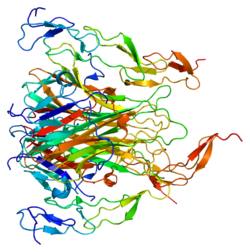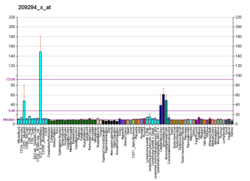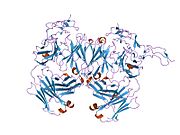گیرنده مرگ ۵
گیرنده مرگ ۵ (انگلیسی: Death receptor 5) که با نامهای DR5، CD262 و گیرندهٔ تریل ۱ نیز شناخته میشود، یک گیرندهٔ سطح سلول از ابرخانواده گیرندههای فاکتور نکروز تومور است که به پروتئین تریل متصل شده و در خزان یاختهای نقش دارد. برای عملکرد صحیح این گیرنده، یک پروتئین وفقدهنده ترارسانی پیام که حاوی دومین مرگ باشد، مورد نیاز است.[۲]
گیرنده مرگ ۵ با پروتئینهای زیر تعامل پروتئین-پروتئین دارد:
در حال حاضر چندین کارآزمایی بالینی بر روی پادتنهای تکتیرهای که علیه این گیرنده ساخته شدهاست، برای درمان چندین نوع سرطان در حال انجام است. یکی از انواع این پادتنها، تیگاتوزومب است.
جستارهای وابسته[ویرایش]
منابع[ویرایش]
- ↑ "Human PubMed Reference:". National Center for Biotechnology Information, U.S. National Library of Medicine.
- ↑ "Entrez Gene: TNFRSF10B tumor necrosis factor receptor superfamily, member 10b".
- ↑ ۳٫۰ ۳٫۱ ۳٫۲ Gajate C, Mollinedo F (Mar 2005). "Cytoskeleton-mediated death receptor and ligand concentration in lipid rafts forms apoptosis-promoting clusters in cancer chemotherapy". J. Biol. Chem. 280 (12): 11641–7. doi:10.1074/jbc.M411781200. PMID 15659383.
- ↑ ۴٫۰ ۴٫۱ MacFarlane M, Ahmad M, Srinivasula SM, Fernandes-Alnemri T, Cohen GM, Alnemri ES (Oct 1997). "Identification and molecular cloning of two novel receptors for the cytotoxic ligand TRAIL". J. Biol. Chem. 272 (41): 25417–20. doi:10.1074/jbc.272.41.25417. PMID 9325248.
- ↑ Chaudhary PM, Eby M, Jasmin A, Bookwalter A, Murray J, Hood L (Dec 1997). "Death receptor 5, a new member of the TNFR family, and DR4 induce FADD-dependent apoptosis and activate the NF-kappaB pathway". Immunity. 7 (6): 821–30. doi:10.1016/s1074-7613(00)80400-8. PMID 9430227.
- ↑ Kaptein A, Jansen M, Dilaver G, Kitson J, Dash L, Wang E, Owen MJ, Bodmer JL, Tschopp J, Farrow SN (Nov 2000). "Studies on the interaction between TWEAK and the death receptor WSL-1/TRAMP (DR3)". FEBS Lett. 485 (2–3): 135–41. doi:10.1016/s0014-5793(00)02219-5. PMID 11094155.
- ↑ Walczak H, Degli-Esposti MA, Johnson RS, Smolak PJ, Waugh JY, Boiani N, Timour MS, Gerhart MJ, Schooley KA, Smith CA, Goodwin RG, Rauch CT (Sep 1997). "TRAIL-R2: a novel apoptosis-mediating receptor for TRAIL". EMBO J. 16 (17): 5386–97. doi:10.1093/emboj/16.17.5386. PMC 1170170. PMID 9311998.
- ↑ Hymowitz SG, Christinger HW, Fuh G, Ultsch M, O'Connell M, Kelley RF, Ashkenazi A, de Vos AM (Oct 1999). "Triggering cell death: the crystal structure of Apo2L/TRAIL in a complex with death receptor 5". Mol. Cell. 4 (4): 563–71. doi:10.1016/S1097-2765(00)80207-5. PMID 10549288.
- مشارکتکنندگان ویکیپدیا. «Death receptor 5». در دانشنامهٔ ویکیپدیای انگلیسی، بازبینیشده در ۳ فوریه ۲۰۱۹.
پیوند به بیرون[ویرایش]
- TNFRSF10B protein, human در سرعنوانهای موضوعی پزشکی (MeSH) در کتابخانهٔ ملی پزشکی ایالات متحدهٔ آمریکا
برای مطالعهٔ بیشتر[ویرایش]
- Abe K, Kurakin A, Mohseni-Maybodi M, Kay B, Khosravi-Far R (2001). "The complexity of TNF-related apoptosis-inducing ligand". Annals of the New York Academy of Sciences. 926 (1): 52–63. doi:10.1111/j.1749-6632.2000.tb05598.x. PMID 11193041.
- Cha SS, Song YL, Oh BH (2004). "Specificity of molecular recognition learned from the crystal structures of TRAIL and the TRAIL:sDR5 complex". Vitamins and Hormones. 67: 1–17. doi:10.1016/S0083-6729(04)67001-4. PMID 15110168.
- Kimberley FC, Screaton GR (Oct 2004). "Following a TRAIL: update on a ligand and its five receptors". Cell Research. 14 (5): 359–72. doi:10.1038/sj.cr.7290236. PMID 15538968.
- Pan G, Ni J, Wei YF, Yu G, Gentz R, Dixit VM (Aug 1997). "An antagonist decoy receptor and a death domain-containing receptor for TRAIL". Science. 277 (5327): 815–8. doi:10.1126/science.277.5327.815. PMID 9242610.
- Sheridan JP, Marsters SA, Pitti RM, Gurney A, Skubatch M, Baldwin D, Ramakrishnan L, Gray CL, Baker K, Wood WI, Goddard AD, Godowski P, Ashkenazi A (Aug 1997). "Control of TRAIL-induced apoptosis by a family of signaling and decoy receptors". Science. 277 (5327): 818–21. doi:10.1126/science.277.5327.818. PMID 9242611.
- Screaton GR, Mongkolsapaya J, Xu XN, Cowper AE, McMichael AJ, Bell JI (Sep 1997). "TRICK2, a new alternatively spliced receptor that transduces the cytotoxic signal from TRAIL". Current Biology. 7 (9): 693–6. doi:10.1016/S0960-9822(06)00297-1. PMID 9285725.
- Walczak H, Degli-Esposti MA, Johnson RS, Smolak PJ, Waugh JY, Boiani N, Timour MS, Gerhart MJ, Schooley KA, Smith CA, Goodwin RG, Rauch CT (Sep 1997). "TRAIL-R2: a novel apoptosis-mediating receptor for TRAIL". The EMBO Journal. 16 (17): 5386–97. doi:10.1093/emboj/16.17.5386. PMC 1170170. PMID 9311998.
- MacFarlane M, Ahmad M, Srinivasula SM, Fernandes-Alnemri T, Cohen GM, Alnemri ES (Oct 1997). "Identification and molecular cloning of two novel receptors for the cytotoxic ligand TRAIL". The Journal of Biological Chemistry. 272 (41): 25417–20. doi:10.1074/jbc.272.41.25417. PMID 9325248.
- Wu GS, Burns TF, McDonald ER, Jiang W, Meng R, Krantz ID, Kao G, Gan DD, Zhou JY, Muschel R, Hamilton SR, Spinner NB, Markowitz S, Wu G, el-Deiry WS (Oct 1997). "KILLER/DR5 is a DNA damage-inducible p53-regulated death receptor gene". Nature Genetics. 17 (2): 141–3. doi:10.1038/ng1097-141. PMID 9326928.
- Schneider P, Bodmer JL, Thome M, Hofmann K, Holler N, Tschopp J (Oct 1997). "Characterization of two receptors for TRAIL". FEBS Letters. 416 (3): 329–34. doi:10.1016/S0014-5793(97)01231-3. PMID 9373179.
- Marsters SA, Sheridan JP, Pitti RM, Huang A, Skubatch M, Baldwin D, Yuan J, Gurney A, Goddard AD, Godowski P, Ashkenazi A (Dec 1997). "A novel receptor for Apo2L/TRAIL contains a truncated death domain". Current Biology. 7 (12): 1003–6. doi:10.1016/S0960-9822(06)00422-2. PMID 9382840.
- Chaudhary PM, Eby M, Jasmin A, Bookwalter A, Murray J, Hood L (Dec 1997). "Death receptor 5, a new member of the TNFR family, and DR4 induce FADD-dependent apoptosis and activate the NF-kappaB pathway". Immunity. 7 (6): 821–30. doi:10.1016/S1074-7613(00)80400-8. PMID 9430227.
- Schneider P, Thome M, Burns K, Bodmer JL, Hofmann K, Kataoka T, Holler N, Tschopp J (Dec 1997). "TRAIL receptors 1 (DR4) and 2 (DR5) signal FADD-dependent apoptosis and activate NF-kappaB". Immunity. 7 (6): 831–6. doi:10.1016/S1074-7613(00)80401-X. PMID 9430228.
- Pai SI, Wu GS, Ozören N, Wu L, Jen J, Sidransky D, El-Deiry WS (Aug 1998). "Rare loss-of-function mutation of a death receptor gene in head and neck cancer". Cancer Research. 58 (16): 3513–8. PMID 9721851.
- Arai T, Akiyama Y, Okabe S, Saito K, Iwai T, Yuasa Y (Nov 1998). "Genomic organization and mutation analyses of the DR5/TRAIL receptor 2 gene in colorectal carcinomas". Cancer Letters. 133 (2): 197–204. doi:10.1016/S0304-3835(98)00230-4. PMID 10072170.
- Mongkolsapaya J, Grimes JM, Chen N, Xu XN, Stuart DI, Jones EY, Screaton GR (Nov 1999). "Structure of the TRAIL-DR5 complex reveals mechanisms conferring specificity in apoptotic initiation". Nature Structural Biology. 6 (11): 1048–53. doi:10.1038/14935. PMID 10542098.
- Hymowitz SG, Christinger HW, Fuh G, Ultsch M, O'Connell M, Kelley RF, Ashkenazi A, de Vos AM (Oct 1999). "Triggering cell death: the crystal structure of Apo2L/TRAIL in a complex with death receptor 5". Molecular Cell. 4 (4): 563–71. doi:10.1016/S1097-2765(00)80207-5. PMID 10549288.
- Kuang AA, Diehl GE, Zhang J, Winoto A (Aug 2000). "FADD is required for DR4- and DR5-mediated apoptosis: lack of trail-induced apoptosis in FADD-deficient mouse embryonic fibroblasts". The Journal of Biological Chemistry. 275 (33): 25065–8. doi:10.1074/jbc.C000284200. PMID 10862756.
- Trauzold A, Wermann H, Arlt A, Schütze S, Schäfer H, Oestern S, Röder C, Ungefroren H, Lampe E, Heinrich M, Walczak H, Kalthoff H (Jul 2001). "CD95 and TRAIL receptor-mediated activation of protein kinase C and NF-kappaB contributes to apoptosis resistance in ductal pancreatic adenocarcinoma cells". Oncogene. 20 (31): 4258–69. doi:10.1038/sj.onc.1204559. PMID 11464292.









